Celtic Caterer
303-359-9654
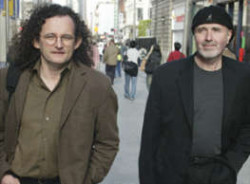
 Traditions stand the test of time, handed down from generation to generation – adding new life, stories, and interpretations to its ever expanding width and depth. During the last weekend of September, Huerfano County will help perpetuate
Traditions stand the test of time, handed down from generation to generation – adding new life, stories, and interpretations to its ever expanding width and depth. During the last weekend of September, Huerfano County will help perpetuate
the traditions of Irish, Scottish, and related Roots music and dance.
Huerfano County is often referred to as “Spanish Peaks Country” for its towering two peaks, West Spanish Peaks and East Spanish Peaks. Indigenous people looked at them with sacred eyes and called them Wahatoya, meaning “Breasts of the Earth.” Part of the Culebra Range of the Sangre de Cristo Mountains, the Spanish Peaks can be seen as far as 100 miles in some directions
Huerfano’s four most populated areas are Cuchara, La Veta, Gardner, and Walsenburg. They are like four siblings with totally different personalities. Walsenburg, the county seat and former coal town, will host the Celtic fest’s Harp retreat as well as the popular Friday and Saturday evening concerts at the historic Fox Theatre. Highlighting the connections between Celtic and Appalachian music, Fridays’ concert, “Scotland meets Appalachia.” will cast the renowned Old Blind Dogs, David Coe and others. On Saturday brace yourself for one exciting Irish hooley when County Clare fiddle sensation Martin Hayes, Dennis Cahill and friends raise the boards. La Veta is a charming artesian town that will house the Celtic fest office and is site of many classes/workshops and activities in the La Veta Park. Take a walk around town where the folks are friendly or jump on the train and go up the pass where bears often scavenge fallen grain that have slid from Coors boxcars. For a rustic mountain experience, travel 10 minutes south along the scenic highway of legends to Cuchara. This mountain village could easily be the set for an old fashion western movie. This is still a secret, but how much fun will happen when the Old Blind Dogs and friends meet at the Dog Bar on Thursday afternoon to start warming up for the Festival? On Thursday evening Gardner will host “A Taste of Things to Come,” a preview party with festival performers playing a few tunes or singing some songs. This “locals” event, is a sell-out each year so don’t your tickets a the last minute. Gardner has a colorful history too. Once the hunting grounds for Utes, Comanche, and Apace, it became home to cattle ranches. In the late 1960’s it became home to hippie communes. Most moved when they discovered the realities of rural living – hard work.
Gardner is also home of the Festival founders, Jack and Barbara Yule. Unafraid of work they moved to the area from Scotland a decade ago from Scotland to homestead on 30 acres. Jack is a harp maker and melodeon player and Barbara a storyteller. The festival grew its roots from informal ceilidhs (Scottish spelling for Ceili) that unfolded when they were visited by friends and family from back home.
The Yules European background is the reason behind the unique offering of a countywide festival. Unlike in America, it is not unusual for festivals in the Celtic regions of Europe (and eastern Canada) to have festivals that are spread out over multiple areas or towns, i.e., Willy Clancy Week, South Sligo Summer School, Fleadh Cheoil na hÉireann (Ireland), Celtic Colors (Nova Scotia), and Celtic Connections (Scotland). “It is as much a retreat as it is a festival,” said Barbara Yule. “We encourage people to come down for a day or two – more if possible, and build your own experience with the festival offerings, world class performers, along with the sights of Huerfano County.”
Oh, can’t forget the Ceili in the ghost town of UpTop on La Veta pass Friday at noon. This is a free event that was started last year and was a blast. Bring a tune, song, or dancing shows and enjoy the session in the old saloon and dance hall. Pack a picnic (snacks will be for sale) and bring your camera, as the sights are beautiful. Also plan some time to visit the chapel and old depot from 1888, once the site of the highest narrow gauge railroad in the world. Now the site of the highest ceili in the world! Did we say the Spanish Peaks Celtic fest is unique?
7th Annual Spanish Peaks International Celtic Music Festival, September 22 – 25, with music and workshops by Martin Hayes and Dennis Cahill, The Old Blind Dogs, Robbie O’Connell (Clancy Brothers, Green Fields of America), David Coe, Ed Miller, Margaret Bennett, Roger Landes, Aine Minoque, Kim McKee, Jennie McAvoy, Claire Mann, Linda Hickman, Tanya Perkins, Shay Dunne, Cleek Schrey and more. Visit www.celticmusicfest.com or call 719-746-2061, 719-742-3003, 719-742-5410, or 303-777-0502 for information and registration.
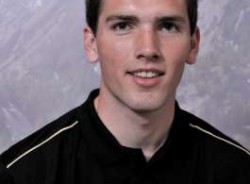
by Alan Groarke
There’s an old Irish proverb that states ‘an ounce of breeding is worth a pound of feeding’. Well that adage can definitely be applied to Darragh O’Neill who has just been announced as the starting punter for the CU Football team. Darragh has never before played in a competitive American Football game in High School or College and only took up punting last winter.
Darragh was born in Ireland with both parents providing a serious Gaelic Football pedigree. His father Colm won All Ireland medals with County Cork while his uncle Maurice Fitzgerald also won All Irelands with County Kerry and is revered for his incredible contribution to the game. Most Irish people would have Maurice in their top 5 Gaelic Football players of all time.
Darragh’s family left Ireland when he was 2 and moved first to Michigan where his father earned an MBA before they settled in Louisville. Colm owns the popular Conor O’ Neills pub in Boulder as well as a sister pub in Ann Arbor, Michigan. Darragh grew up playing Baseball, Soccer and Basketball before concentrating on the latter two sports in High School. However, it looked like a promising sports career would be cut short when Darragh fell ill with a rare blood disease during his sophomore year. The illness baffled doctors and caused his lungs to hemorrhage just before he slipped into a coma for five days. A priest delivered last rites, and the outlook did not look good. Amazingly, he bravely fought the illness and eventually recovered back to full health. Doctors felt it would be quite some time before he would be able to play sports again and probably not competitively because of the damage to his lungs. This would not deter Darragh who worked hard on his fitness and managed to recapture his place on the Fairview High School Soccer and Basketball teams. He was an All-State soccer player and led the basketball team to back-to-back Class 5A State Championship Finals with thrilling displays along the way. He was named Colorado Basketball Player of the Year in 2010 and averaged over 23 points a game as a point guard.
Surprisingly, Darragh did not hear from many Division I colleges – only the University of Denver invited him as a walk on although he had many Division II scholarship offers. Instead, he enrolled at CU but did not play basketball or soccer in his first year. Then last winter, Darragh took up punting, thinking it might be a way to play major-college football. “I played soccer, so I knew I had a decent leg anyway, so I just started working on punting with my dad, trying to figure it out…It was something I always wanted to do in high school. I just never felt I had the time.”
A friend hooked him up with local kicking coach Matt Thompson and a tryout with CU special teams coach J.D. Brookhart in March led to Darragh getting his shot. He immediately caught everyone’s eye after kicking a number of monster kicks. Darragh then had a battle on his hands all through the spring and summer to perfect his technique and ensure he had a consistent kicking game. He was competing against two other seasoned punters but CU Head Coach Jon Embree was convinced by Darragh’s skill, determination and toughness. He named the twenty year old as the starting punter for CU’s first game, which takes place on September 3rd in Hawaii.
It’s unheard of that someone plays their very first competitive game in a sport live on ESPN in front of a national audience. But then ‘Darragh’ in Gaelic means “oak tree” and it is that tenacity which has seen him recover from a life threatening illness and rise to the top of all sports that he has decided to play.
Not nearly satisfied with baseball, soccer, basketball and American football, he is an accomplished rower and has played Gaelic Football. Under the tutelage of his famous uncle Maurice, not only did he learn rowing, but he took home an All Ireland Rowing Medal after just a summer learning the sport. Darragh also has a North American Under 18 Gaelic Football medal, won while playing for our very own Denver Gaels. Indeed, he probably would have been able to contribute more to the club if his summers weren’t spent in Ireland with his family.
Darragh comes from a family of eight where sports plays an integral role and they continue to provide a conveyer belt of talent to sports teams here in Colorado. His brother Shane is also an outstanding soccer and basketball player and played with Fairview in the State Basketball Final last year. He is currently on the development squad for the Colorado Rapids and would love the opportunity to play professional soccer. Darragh has two other brothers – Enda and Mark and two sisters – Kate and Grace. His parents Colm and Christine regularly spend their weekends chauffeuring the kids to different tournaments around Colorado. CU now want to take over that role starting with a trip to Hawaii for Darragh’s debut as an American Football punter.
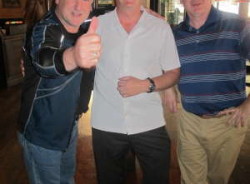
Uilleann piper Davy Spillane was at Hastings College, Nebraska to receive
a Doctorate in Fine Arts for his works in making Uilleann Pipes.
He swung into Denver for a couple days with Richard Lloyd, Professor of
Irish Literature at the College. He is pictured above at Celtic Tavern in Downtown Denver. L-R Spillane, Noel Hickey, and Lloydrish L
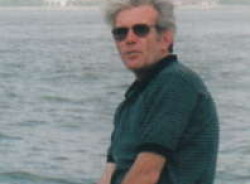
Charles “Chuck” McLaughlin, 59, passed away suddenly on Sunday, June 12, 2011 in Albuquerque, New Mexico at the home he shared with Judi, his wife and best friend of 42 years.
A few years ago a band that we have history with asked Celtic Events/ The Celtic Connection to promote and produce a show in Albuquerque, New Mexico. In some ways this was a bad idea since we had never been there before, knew no one, and the town had a reputation as a tough market for shows. On the other hand, the idea was appealing
since it fit into our plans to expose the Celtic Connection newspaper as a niche resource to as many folks, businesses, and organizations as possible who live, work, and play up & down the Rockies. I decided to take the opportunity to reach out further with the CC and took the show.
From Denver I researched Irish/Celtic organizations in Albuquerque – One of the names I came across was Chuck McLaughlin, Irish Freedom Committee. When I contacted Chuck I learned that he had also been a member of the Irish American Society of New Mexico and had publicity experience as media director for the Rio Grande Celtic Festival. When he understood what we were attempting to do in “Albu” he immediately went to work putting together names, numbers, and ideas that might assist us in promoting the show. I was so impressed by the effort he made to help a person that he had never met. He never tried to feel me out to learn who I voted for, what I prayed to or any other hot-button topic of judgment – he was just trying to help another human being who needed a hand. I soon learned that this was not an isolated incidence – Chuck was a man who unconditionally helped people as a way of life.
There was more than a little nail biting when we drove from Denver to Albuquerque for the show. Soon after we arrived at the venue Chuck and his good buddy Don Murphy showed up and asked, “How can we help?” I can’t tell you how comforting those words were, as we were working with a skeleton crew of my wife, me, and our then four year-old boy – who wasn’t much help but a good source of entertainment.
Subsequent trips to New Mexico always came with advice and helpful tips from Chuck. He loved New Mexico, and would always have good travel suggestion -given in his candid delivery, “..Most New Mexicans consider Santa Fe to be a waste of time and money…Taos is a far more friendly and affordable town and is my own favorite NM town.” Heavily involved with the Celtic League and the Irish Freedom Committee, Chuck would forward press releases to me regularly for consideration in the Celtic Connection. He was never pushy, presumptuous, and did not show contempt if his article was not published. But, when something was published about NM or one of his projects, he was over the moon with gratitude, making comments like “Dinner’s on me!”
By coincidence or by one of those serendipitous moments that get you wondering about a bigger picture, I came across one of those grateful emails from Chuck the night before he died. It said, “I owe you Pat and you know that whenever you and your family find your way to New Mexico, you stay here as our guests.” No Chuck, I owe you. Our thoughts and prayers go out to Chuck’s friends and families. He will be remembered and missed. Pat McCullough The Celtic Connection/Celtic Events
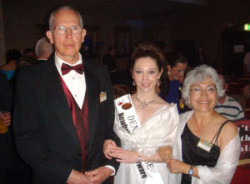
Photo: Keriayn with dad, Bill, and mom Teresa
Keriayn O’Donnell has recently returned from Ireland where she was competing in the regional finals of the 2011 Rose of Tralee Festival.
Keriayn was the first local girl to be chosen to represent the City of Denver as the Denver Rose in this prestigious event. Although she performed well in all aspects of the four day event, she was not among the girls chosen to attend the finals to be held in August. The competition was fierce and, unfortunately, only 23 of the 51 entrants could advance to the finals. Besides the disappointment of not advancing to the finals, Keriayn suffered a stress fracture in her foot the first night of the competition and was not able to perform the slip jig she had been practicing for the judges. She elected instead to perform a piano piece.
All in all, though, the trip was a good one for Keriayn and her family as they were able to do some sight seeing before her competition and visit with cousins in Cahir, County Tipperary. In a show of family support, six O’Donnells from Tipperary attended judged events during the festival.
Keriayn will continue to represent the Denver St. Patrick’s Day Parade Committee at State and local functions as Queen Colleen until her successor is chosen this Fall.
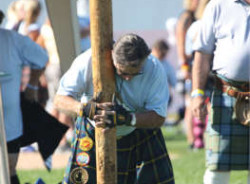
 Nessie’s been sighted and it’s reported she’ll surface at the 48th Annual Colorado Scottish Festival and Rocky Mountain Highland Games on Saturday, August 13 and Sunday, August 14 at Highland Heritage Park, 9651 South Quebec (two miles south of
Nessie’s been sighted and it’s reported she’ll surface at the 48th Annual Colorado Scottish Festival and Rocky Mountain Highland Games on Saturday, August 13 and Sunday, August 14 at Highland Heritage Park, 9651 South Quebec (two miles south of
C-470)., this family-friendly festival is open from 9 a.m. to
10 p.m. on Saturday, and 9 a.m. to 5 p.m. on Sunday.
For tickets, event schedule and information, contact the Festival hotline at 303-238-6524 or visit
Colorado Scottish Festival
Hosted by the St. Andrew Society of Colorado, a non-profit 501(c)(3) organization founded in 1963 to provide all persons the opportunity to pursue their interest in Scottish culture, the festival’s heritage can be traced back to Scottish fur trappers who carried on age-old homeland traditions in their Rocky Mountain encampments.
Attendees will experience the power of the massed Pipes and Drums on parade; the grace of Scottish and Irish Highland dancers; historic re-enactors staging mock battles; sheepherding, Birds of Prey and rugby demonstrations; and the comical antics of dogs of the British Isles. They can participate in Scottish country dancing and Tug-of-War; shop for traditional Scottish wares in the Market Square; and trace their ancestry and clan history at the Scots’ Heritage Centre. “Wee bairns” will have plenty of their own fun games and activities so parents can enjoy the day.
Four festival stages will offer non-stop Celtic music, and vendors will be selling such Scottish-Irish fare as haggis, Scotland’s savory “soul food”. Those of an age can enjoy a cold brew or wee drop of Scotland’s finest whiskey in one of several pub tents. Gentlemen wearing kilts are invited to enter the Bonny Knees Contest, judged by fair lassies.
The Rocky Mountain Highland Games will consist of fierce competitions in Highland dancing, piping and drumming, and traditional Scottish athletics, including the trademark caber toss (big, brawny men throwing heavy wooden poles).
During Midday Ceremonies both days, the skirl of the Massed Pipes & Drums will accompany a spectacular Parade of Clans and British dogs. On Saturday, the 5 p.m. Hot Piping Contest will be followed by a musical extravaganza from 7 to 10 p.m. featuring famed Celtic rock band, Seven Nations. On Sunday’s schedule — a British car show featuring MINI Coopers from the Festival’s Title Sponsor, Ralph Schomp MINI, and new and classic cars owned by members of MINI5280, the Motoring Society of the Rocky Mountain Region.
Tickets can be purchased in advance or at the door. Admission: Adults, $17; Seniors (60+), Active Military, Children 7-11, $12; Children 6 and under, Free. Free parking available at Highlands Ranch High School, 9375 Cresthill Lane; and Rock Canyon High School, 5810 McArthur Ranch Road. Free shuttle from both locations.
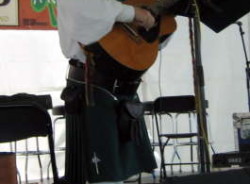
 Photo: Michael Thompson at last years CIF
Photo: Michael Thompson at last years CIF
The cultural offerings at the 2011 Colorado Irish Festival’s Cultural Village are the heart and soul of the weekend event, showcasing some of Colorado’s talented groups, organizations, and individuals that perpetuate Irish culture all year-round.
One such individual is local Celtic musician and storyteller Michael Thompson. Not only is Michael a Chairperson for the Cultural Village, but he will lend his talents with an updated version of his presentation on “The History of Ireland in Story and Song.” “It’s not easy to encapsulate ten thousand years of Irish history in an hour,” said Michael, “But if you’ve ever wondered about the origins of the Irish people, this is your chance.”
One of Michael’s friends in the Colorado circle of storytellers is Denis Michael John Gorman McCarthy Gessing – and with a name like that, you know there has to be a story! The “American-Irish Seanachi” ( Seanachi, variation on the spelling of the word for a traditional Irish storyteller/historian) keeps the oral tradition alive, with stories to delight audiences from the wee to the ancient. Born in Colorado to third generation Irish parents, Denis gives life to Irish Folk Tales, his own stories and those of Frank Delaney. “The American/ Irish Seanachi reminds you that while the ancestors had to leave Eire, Eire never leaves you … so long as there’s the Seanachi.”
As anyone from Ireland can attest, the local pub has been a key part of Irish culture for many years. According to Michael the pub is an integral part of the Cultural Village. “The pub is not just a place to drink – in Irish culture, it’s a center of social life, where the community gathers, old friends meet up, and new friends are made. Irish pubs are famous for their music and craic (pronounced “crack,” an Irish word for good times and friendship), and you will find plenty of both in the Cultural Village Pub.” Local acoustic Irish traditional music will be provided by Skean Dubh, Mythica, Colcannon, Gobs O’Phun, Lougheed, and Mondragon. Also, traditional music sessions Friday and Saturday evenings, featuring musicians who gather to play just for the joy of it, much like what happens in most local pubs in Ireland – so stop by for a listen, or bring your own party piece (tune or song)!
For centuries the Harp has been recognized as a national symbol of Ireland. Thanks to sponsorship from Denver company Kolacny Music, you can learn to make angelic sounds from this instrument. Harps will be provided for learners for a “hands-on” workshop with instruction from Lisa Clark of the Colorado Harp Society.
Another instrument with a strong Irish identity is the Uilleann Pipes. The name comes from the Irish term píoba uilleann which literally means, “pipes of the elbow.” Unlike the Highland and other pipes, the uilleann pipes are inflated by means of squeezing bellows strapped between the waist and arm with one’s elbow. The bellows relieve the player from the effort needed to blow into a bag to maintain pressure. The uilleann pipes allows pipers to converse or sing at the same time as playing – or as the famous Irish piper and singer Finbar Fury once said at a Denver concert, “The Irish designed the pipes to make the mouth available for a pull on the pint.” You can have an up-close-and-personal look at this uniquely Irish instrument when Colorado Uilleann Piper Eric Olson conducts his presentation of “Kitchen Music.” According to Michael, Eric will recreate the facet of traditional Irish music culture, where friends and neighbors gather in the kitchen for informal sessions, playing tunes and sharing songs, and maybe and occasional dance. “You don’t want to miss this, in his own inimitable style, Eric will cook-up a presentation where audience participation will happen!”
You can learn how to pronounce “uilleann” and other words and history of the Irish language when Ireland native Mick Bolger gives his presentation, “The Broken Tradition.” The front man for the Irish band Colcannon and student of the language will bring insight and instruction in the colorful language promised Michael, “This is not just a “tea towel” approach to a few tourist phrases, Mick’s workshop will give you a new understanding and appreciation of the Irish language and how it influences the culture, even among those who no longer speak it.”
Want to find your family tree? Marylee Hagen, a member of W.I.S.E. (Wales, Ireland, Scotland, England) Family History Society (which will also have a booth in the Village), has been doing genealogy for 16 years. She is a teacher by profession, and has given many adult and student programs on genealogy and Ireland. Marylee will give a presentation on “Tracing Your Ancestor’s Footsteps.” She found her family roots in southern Ireland by tracing her ancestor’s footsteps backwards to their homelands in County Kerry. She will start with first researching in the United States and then go abroad. Strategies, tips and resources will be shared and examples displayed.
Colorado historian Sherman Bucheger will share two presentations this year at the Fest. The first, “The Irish Famine in America,” will discuss details of the 1845-46 potato blight in Ireland, the resulting famine, and the emigration of millions of Irish, many to North America. This vast migration had widespread effects in both countries, which continue to change the face of American culture to this day. “The Irish in the American Civil War; The Union Irish Brigade” will briefly discuss the role of Irish and first generation Irish-Americans in the American Civil War of 1861-1865. The discussion will focus mainly on the involvement of the Irish in the Union Irish Brigade under the command on Thomas Francis Meagher from the battle of Sharpsburg in 1862 through the unit’s involvement in the Battle of Gettysburg in 1863. Topics to be discussed will include why the Irish fought for both the Northern and Southern causes during the war, the use of Irish troops by both the Union and the Confederacy during the early combats of the war, and a possible reason why current day knowledge of the Irish during the war Civil War is so limited.
Michael was pleased to point out some of the Colorado groups and organizations that continue to fly the flag of Irish culture all year-round, will have booths in the Cultural Village, they include:
The Colorado Emerald Society fraternal organization of police, firefighters, and public safety personnel, promotes Irish culture and traditions among those valued professionals. CES also sponsors a pipe and drum band that represent the State of Colorado at the National Peace Officers Memorial March and Service in Washington D. C., and the International Fallen Firefighters Memorial Service in Colorado Springs, as well as leading the Colorado Emerald Society in Denver’s St. Patrick’s Day Parade.
The Denver St. Patrick’s Day Committee will be represented, dispensing information about one of the most prestigious St. Patrick’s Day parades west of the Mississippi.
Every year, the Ancient Order of Hibernians and its auxiliary, the Ladies AOH
The ever-popular Irish Wolfhounds will make a return visit, and this year, we feature a special display of Viking craft skills and handiworks, by Iðavellr Vikings . Vikings came to Ireland many times, in bands small and large, and made significant contributions to Irish culture. Iðavellr Vikings is both a Crafter’s Guild and Living History group, situated in Colorado. Iðavellr is old Norse for the place where the Norse gods rest after battle; a place where crafting and camaraderie ensues. The Iðavellr village will represent how Norse people lived during the Viking Age, traditionally circa 700 C.E. to 1066 C.E. Its members portray Norse people from various countries sometime during that period. Nearly everything they have is hand-made, from clothes and shoes to kettle and knives. During the festival, they will display things they’ve made that Norse people would have had, and work on Viking-Age crafts, such as shoe making, nålbinding, tablet weaving, spindle spinning, and so on.
And of course, no discussion of Irish culture would be complete without the mention of distinctively Irish sports, such as Gaelic football and hurling. Michael explains the games, “Gaelic football predates the modern sport of soccer, and resembles that sport as well as rugby, but with some unique Irish twists. Hurling looks a bit like field hockey, but is played by much the same rules as Gaelic football. Colorado is the proud home of the Denver Gaels.” Dublin native and local “D.J.,” Shay Dunne (and co-founder of the Gaels) and some of his teammates on the Denver Gaels, will explain the importance of traditional Gaelic Athletic Association (GAA) sports in Irish culture. This will be followed by demonstrations of these quintessential Irish games that include Irish Football and Hurling. The Gaels will also host teams from outside Colorado in GAA competition all weekend at the Fest.
,
Check the Cultural Village schedule at Colorado Irish Festival, click on Events, and scroll down to Cultural Village
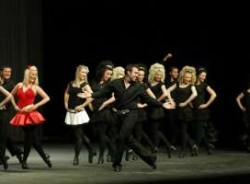
 Photo: Professional Irish Dance Troupe, “Strictly Irish” will perform Saturday at 1p.
Photo: Professional Irish Dance Troupe, “Strictly Irish” will perform Saturday at 1p.
Barleyjuice · Albannach · Enter the Haggis· RUNA · McPeake · Seven Nations Colcannon · The Indulgers · The Hounds of Finn · Potcheen · Mythica · Gob’s O’Phun Skean Dubh · Mondragon · Juice O The Barley · Lougheed · Strictly Irish Dance Troupe Irish Dance· Michael Thompson · Pipe Band Competition · Denver Gaels Irish Sports Cultural Village & Pub · Storytelling · Celtic Marketplace · Kids Area · and a beautiful view of the Rocky Mountains from the reservoir at Clement Park! CLEMENT PARK, 7306 W Bowles Ave, Littleton, Colorado 80123 Dates/Times: Friday, July 8th 5pm – 10pm Saturday, July 9th 10am – 10pm Sunday, July 10th 9am – 6pm Cost: Free for Kids 12 and under all weekend! Free Parking & Shuttle! Friday, Free for all who arrive at the Festival Main gate 5pm – 7pm. After 7pm, $5 per person (12 & under Free). Saturday & Sunday Advance: $12, $8 Seniors over 65, students with valid ID and Military personnel with active ID, (12 & under Free). Saturday & Sunday at Gate: $15, $10 for Seniors over 65, students with valid ID and Military personnel with active ID, (12 & under Free). Sunday Mass 10am on Celtic Stage. Admission is free between 9-11am. A free-will offering of non-perishable food items will be accepted the main gate. Donations will benefit the Denver Rescue Mission. Advance Tickets Available at King Soopers, Telephone 866.464.2626 or 719.576.2626. Information/Tickets online at Colorado Irish Festival
Every Year since 1994, the Colorado Irish Festival has been showing folks how to have fun the Irish way! Be Irish July 8-10 at Clement Park, in Littleton! Entertainers scheduled to provide the musical backdrop this year include: Barleyjuice, making their Fest debut, will bring their highly contagious care-free Irish Rock. Their music has been chosen for TV and film (The Office, King of the Hill, Driven) and has been consistently ranked as “Best” by Irish newspapers; Also making their first appearance is RUNA. Contemporary yet leaning on the side of tradition, the band features Shannon Lambert-Ryan on vocals and monster acoustic guitarist Fionán de Barra (from Ireland’s musically renowned De Barra clan); Whether their shirts stay on or off, Albannach will call to your primal Celtic passions with pulsating tribal drums and bagpipes; McPeake, born from the legendary musical family and school from Belfast, will continue the family’s 100 year legacy of excellence with their third consecutive visit to Colorado; Also returning are Seven Nations and Enter the Haggis, two high energy bands with a history of rocking the house – 7N was described by one critic as “Explosive Seven Nations blows Palace into orbit … you’d be hard pressed to find a more original, unique but accessible group … powerful self-penned tunes and transcendent live shows. A musical force to be reckoned with, Seven Nations’ day has come.” ETH has been landing Billboard and iTunes World Music charting as well as major television appearances on shows like Live With Regis And Kelly, A&E Breakfast With the Arts and PBS’ popular program Out of Ireland, with its multi-influence style of Celtic rock. Colorado native and fiddler Michelle MacGregor will return to her old stomping grounds with her new band Hounds of Finn from St. Paul; Some of Colorado’s best bands who will be at the Fest, include Colcannon, The Indulgers, Potcheen, Mythica, Gob’s O’Phun, Skean Dubh, Mondragon, Juice O The Barley, and Lougheed. There’s loads more happening with Irish dance competitions and Irish dance performance by Colorado’s only professional Irish dance troupe Strictly Irish. Strictly Irish is comprised of four Riverdance and Lord of the Dance former Principal dancers, six World Champions, two 2010 World Championship medal holder, two 2010 Western Regional Champions. They have been seen on PBS and on tour with Celtic Fire. Current members: Shaun Casey, Aisling Toal-Casey, Martin Percival, Louise Connolly, Marcia Speights, Jessica Lesser, Eimear Toal, Hannah Hofreiter, Kate Shinnick, Blaine Donovan, Levi Hachi with a special guest performance from the 2011 World Champion Team “The Girls of Belfast.” Dueling Bagpipes will compete for awards and bragging rights; The Cultural Village will offer storytelling, music, history, and Irish genealogical workshops for adults and kids. Don’t miss the Denver Gaels as they battle it out in Irish Sports with teams from around the country. And of course spend some time to shop the Celtic artisans and other vendors, and enjoy plenty of food and drink Come and be Irish this weekend!
www.ColoradoIrishFestival.com The Colorado Irish Festival is presented by The Colorado United Irish Societies (CUIS), a qualified non-profit organization incorporated in 1995 as a 501(c)(3).
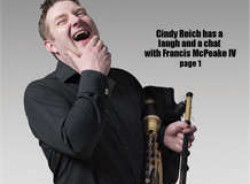
Cindy Reich talks with Francis about over 100 unbroken years of uilleann piping in their family, the latest status of their McPeake Music School and teaching John Lennon to play the uilleann pipes.
The McPeake band will at the Colorado Irish Festival, Clement Park, Littleton CO July 8th and 10th.
Colorado Irish Festival
CR–Your name needs no introduction in the world of Irish Music, but there may be people in the U.S. who are not as familiar with the lineage and the history of your family. You’re the fourth in a series of McPeakes who play the uilleann pipes.
FM It all started with my great-grandfather, who was born in 1885. He was called Francis McPeake and since then, every first son has been called Francis. For some unknown reason he developed a love for the Irish bagpipes, also known as the uilleann pipes and also developed a love of Irish traditional music. So it has been going on now for over 100 years.
CR Now, your great-grandfather learned the pipes from blind John O’Reilly who was from Galway, is that correct?
FM That is absolutely correct! Now there is not a lot of people who know that! If we look at Irish music today, it is a global world music, but at that time, around 1904-1905, Irish music was literally dying. So to find a piper, my great-grandfather had to find one all the way down in Galway. At that time it would have taken 8-10 hours for him to get from Belfast to Galway. So the blind piper had to go on the train from Galway to Dublin, then from Dublin to Belfast. He actually lived with my great-grandfather for six months because that’s how long it took to learn the foundation of learning the pipes—but also to make that long journey worthwhile.
CR The uilleann pipes would have been quite rare in Belfast at the turn of the century, would it not?
FM Most certainly. What happened was, a historian based at Queens University was a good friend of my great-grandfather’s. He was very involved in keeping the music and language alive. His name was Francis Joseph Baker and he heard that my great-grandfather wanted to play the pipes so he went on a mission—find out who made pipes and where to get them.
There is a funny story in that. There were two sets of uilleann pipes and two harps that were put on a boat with a couple of Irish guys to go to the St. Louis World’s Fair. Well, when the instruments arrived in America, lets just say that the Irish guys were a wee bit worse for wear—from too much Guinness. The Irish guys got off the boat, but the instruments stayed on the boat and the instruments ended up back in Ireland. And from that misfortune of events, my great-grandfather got a set of pipes. And its very, very strange, but about 40 years later, they actually got one of the harps as well. That’s how rare uilleann pipes were at that moment in time. We still have that set of pipes at the house. But we also have a set of pipes by a Glasgow maker. Even now, the pipes I play at the moment—the drones and regulator are made by a Cork maker, and my chanter is made by a guy in Vermont! So you find great makers all over the world now.
CR—Every pipe player that has played in Colorado has cursed our altitude and climate. Have you played the pipes in Colorado before?
FM—I’ve been fortunate to be asked to play in Colorado twice before at the Irish Festival, but I’ve been unfortunate enough to be a piper at the Colorado Irish Festival (laughing). It is without a doubt one of the worst places on the face of the earth to play the pipes. Because of the cane that is in the chanter reed. It is very susceptible to altitude and destroys very easily in the climate of Colorado. You could very easily play the pipes in Colorado and by the time the gig is finished, the reeds are destroyed.
CR—Well, I’ve heard of pipers trying reeds that were made here in Colorado when they play the pipes here so that they are acclimatized. Does that work?
FM—Well, its not that they have to be physically made in Colorado. For example if I got reeds from my maker in Vermont, I would have to send them to Colorado and have them taken out and get accustomed to the Colorado climate for a couple of weeks, they would probably be playable, I’d say. Even my own reeds—my father is making mine at the moment, it would take a couple of weeks to get them used to the Colorado weather. So lets just say that when I get on the plane from New York for Colorado, the grey hair will already be starting to appear on my head!!
CR—We’ll forgive you any odd sounds when you arrive, then!
FM—Any squeaks or squawks that you hear? Thank you very much!
CR—We’re just glad that having played the pipes in Colorado, you are willing to come back and do it again!!! Now the McPeake family has been responsible for teaching hundreds of students over the decades and like all other arts organizations is having trouble staying open. Tell us what the status is at this time of the McPeake School Of Music?
FM—Basically, as you said yourself, it’s on extremely hard times at the moment. We’re at the point of maybe having to close. We’ve been going since 1977, so for over 30 years. We’ve been unable to maintain the facility we’ve been in for the last 7 or 8 years, because as soon as the recession hit, the first thing to lose funding was the arts.
It was the first thing to happen in Belfast, and has happened to the arts all across Ireland. But what you are faced with, when people are feeling like this, what people need the most now—is the arts. We’re always looking for funding. We’re always looking for money. We’re always trying to keep the heart of Irish traditional music alive in Belfast.
CR—If people want to learn more about the McPeake School of Music, is there a website up?
FM—There is a website—www.francismcpeake.com but it is getting totally refurbished and should be up around the end of July. It will be a multi-media site with a lot of great things up on it soon!
CR—With all the legendary history to your family and all the pipers, do you have most of the pipes that have been played in your family? For example, do you still have your great-grandfather’s set of pipes?? Who made some of the pipes in your family? Are there any pipe makers within your own family?
FM—No, no pipe makers. My father made my bellows and my reeds. There’s a fellow in Scotland called Craig Ballantyne—he makes my bag, the drones and regulators are made by Alphonsus Kennedy in Cork and my chanters are made by Benedict Koheler in Vermont.
But what I can say is yes; we still have all those sets of pipes. My father is playing his set, which was made by Kennedy of Cork, also. Those pipes were actually made for John Lennon. When my father was teaching John Lennon to play the pipes with the Beatles and John no longer wanted them, he let my father keep them.
Equally, at the same time, we have my great-grandfather’s set which was made by R.L.O. Mealy at the turn of the century in the key of C. My father and I play in the key of D. So we have a whole range of pipes. We even have a set of pipes made by the legendary piper Leo Rowsome.
CR—Well of course, this now begs the question—if your father was teaching John Lennon how to play the uilleann pipes—did John really learn how to play, or did he just dabble with it?
FM—Believe it or not, I was with my father just a few nights before I left for this tour and we were watching a documentary on John Lennon. And I asked him, “What was John Lennon like as a student?” And it was just the two of us in the living room and he wasn’t going to tell any fibs—as they say.. And he turned around to me and said, “Son, I can honestly say, he was the best student I ever had”. He came to terms and grasped the concepts of the pipes-how to play, and what was needed to become a piper quicker than any other student he ever had. So there you go.
CR—That is absolutely amazing. Because a lot of people like the idea of the pipes, but when they find out what it really takes, they bail out pretty quickly.
FM—Equally, at the same time, the McPeake family were not only known as pipers but as singers. My great-grandfather, grandfather and father were able to sing and play the pipes at the same time. Unfortunately the gene has not been passed down to me–yet.
CR—And that had never been done before—singing and piping at the same time, until your great-grandfather did it.
FM—No, never. So if we bring ourselves back to the beginning of this interview and blind John O Reilly—after they parted ways in 1904– in 1912, my great-grandfather entered the World Championships of piping, called the Oireachtas, in the Junior section. But he did not know that his old tutor, John O’Reilly was in the senior section.
John came into the room where my father was piping for his competition. Neither one knew the other was there, and after my great-grandfather finished playing his first set of music, John O’Reilly stood up and said, “Francie—sing them a song—sing them a song!” Because he was the only person John O’Reilly had ever come across who could sing and play pipes at the same time.
www.francismcpeake.com www.mcpeakemusic.com
(If you go to YouTube and type in McPeake, there is footage taken by Pete Seeger of Francis’ great-grandfather, grandfather and father playing and singing simultaneously)
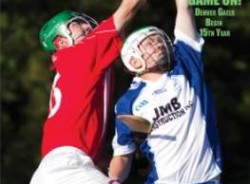
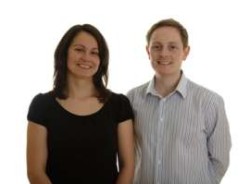
Pat McCullough chats (phone & email) with BitesizeIrishGaelic.com founders Eoin and Saša Ó Conchúir and Denver student Mary Price
Eoin Ó Conchúir grew up in Ennis, Co. Clare (Inis, Co. an Chláir) in the west of Ireland. While there were Irish-speaking communities in the west of Clare up until only 50 years ago, it’s an English-speaking area now. However, it still has a strong sense of all things Irish, and is renowned for its traditional Irish music. It’s there were he family raised himwith Irish as first language at home. “Interestingly, neither of my parents were themselves native Irish speakers, in that their primary home language had been English. But for different reasons, they ended up bringing up the family through Irish. When I was younger, I remember being pretty embarrassed speaking to my parents in public in Irish. These days, though, I have nothing against being heard speaking it in public!”With passion as the underlying force for many of life’s “twists of fate” their enthusiasm for the Irish language motivated Eoin and wife Saša to develop BitesizeIrishGaelic.com (BIG (an ironic acronym for something Bitesize!)) in their spare time. According to Eoin, BIG just grew out of a hobby. “The idea for teaching Irish online was brewing in 2008. I had already been running Irish language sites since 1996. Actually, it just started with a personal web page that included a paragraph in the Irish language. As the page grew, I was getting some emails already from people asking for translations. The Web was still in its infancy, and I think we were all excited to be suddenly able to talk to others in different countries. The translations got a bit much, and I set up irishgaelictranslator.com in 2002.
Questions about the Irish language from people around the world continued to find Eoin and Saša. Many are for one-off translations, but others want to actually learn to speak the language. “In summer 2008, on vacation, I had my notepad out trying to think of new web site ideas. It was a lovely sunny day, we were having some beers, and the idea of online Irish Gaelic lessons started to form.” Two years later, they launched the beginnings of Bitesize Irish Gaelic.
Eoin talked about his wife and her non-Irish heritage as being a major factor in the development of BIG. “We met in Slovenia a decade ago where we were both at a kids’ summercamp. Slovenia is nestled in Central Europe, and has Alpine regions along with a Mediterranean/Adriatic coast and inner rolling hills. In some ways, I found Slovenia and Ireland to have similarities, not least of which both have small populations. We’ve been married now for several years, and living in Limerick in Ireland. Learning Irish has been a different experience for Saša than I learning Slovene. In Slovenia, I’m immersed in hours of family conversation and the wider environment. For Saša, she hears our family speaking Irish at times, but not that often. In other words, it’s not an immersion experience. I still think that actually spending a considerable amount of time immersed in your target language is just about the most valuable way to get your brain to switch. Otherwise, you must make use of as many types of resources as possible available to you. Sasa told her story in an email describing her Irish language learning process. “Coming from a small country like Slovenia, with a population of only 2 million, for me language is an important aspect of social and cultural identification. Visiting Ireland I realized that very few people spoke Irish, but those who did felt strongly about it. Despite the fact that I never actually had to use Irish in Ireland I still wanted to learn it to grasp the special cultural connotations of the Irish language. Eoin always has ideas about promoting Irish Gaelic and a couple of years ago he came up with a collaborative online Irish dictionary (which is now Irishionary.com or Focloirgaeilge.ie) and developing lessons in Irish Gaelic (and probably several more that were forgotten and will never see the light of day). I was attempting to learn Irish at the time and a lot of books and computer lessons were either too general or too detailed, but mainly too extensive and broad. What made us think about developing short, straight-to-the-point, so-called bitesize lessons was, first, the natural fact that I as an adult learner found it draining when I tried to grasp dozens of pages of language concepts. As we found out through our research, to learn a language effectively one should only learn in 30 minutes sessions and from personal experience I could definitely confirm that. Secondly, there are the economic demands of the modern society which means we work longer hours and have less free time for interests and hobbies. In order to fit learning a language into a busy lifestyle the lessons had to be short for people to stay focused and engaged for long enough to learn enough basics to be motivated to learn more complicated concepts later on.”
Eoin admitted that despite growing up with two languages, and both he and Sasa studying and working in France previously, that he still doesn’t feel like a “languages person”. But, he does feel strongly about what method of learning works for him and others. “ I find it hard to grapple with specific grammar rules as many other people also do. I do better with listening, repeating, and by making mistakes. From this, the whole idea of Bitesize Irish Gaelic is to make learning as easy as possible by breaking the lessons into just the right ‘bite size’. He adds a word of warning, “Do not underestimate the amount of work and the number of hours you’ll need to advance in being able to interact in a language. From this, we know we can’t make the learner frustrated or angry, but rather teach small chunks at any one time.” Eoin also sights Studies that have shown that regular revision is key to learning. “We recommend learners to take a lesson or two on any learning day, but to mix between learning a new lesson and revising a previous lesson.”
When asked what kind of feedback have they been getting from BIG users Eoin nearly jumped through the screen, “Wow, the feedback has been what keeps us going!” Adding, “People have been very open about how these online lessons have been helping them out, in combination with other learning sources such as listening to Internet radio. Only last week I was in contact with Patrick, a university student in Pittsburgh, Pennsylvania. He was always interested with his Irish connection, and he said learning some of the language was the next step in building that connection. He told me that he found the lessons so addictive that he was spending more time on the lessons than on his university studies!”
Denver, Colorado resident Mary Price, turned the Celtic Connection on to BIG, and is an ardent fan of the program, says, “The Bitesize method allows a person to take their time, go at their own pace and is easily accessed for review. There are also forums set up where other students can communicate with each other and share tips on learning. The feature I appreciate the most is that Eoin actually takes the time to contact students by phone and chat with them on how they are doing and answers any questions they may have. The personal touch means a lot. He is also very accessible thru e-mail contact as well. I love this program and would highly recommend it for anyone interested in learning a language.” Mary added enthusiastically, “At only $12.00 a month you can’t beat that!”
Eoin and Saša said that they have enjoyed a holiday in California, but look forward to visit Colorado or the Rocky Mountain Region someday soon. Take a visit to Bite Size Irish http://www.bitesizeirishgaelic.com/celticconnection/ where you can learn a bit of Irish to give them a warm welcome. They’ll have a 50%-off the first month coupon code for Celtic Connection readers.
